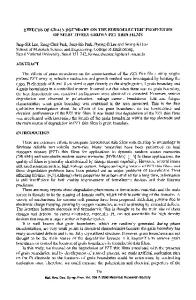Compositional Effects on the Piezoelectric and Ferroelectric Properties of Chemical Solution Deposited PZT Thin Films
- PDF / 294,999 Bytes
- 6 Pages / 612 x 792 pts (letter) Page_size
- 100 Downloads / 317 Views
Compositional Effects on the Piezoelectric and Ferroelectric Properties of Chemical Solution Deposited PZT Thin Films DONG-JOO KIM, JON-PAUL MARIA, and ANGUS I. KINGON Department of Materials Science and Engineering, North Carolina State University, Raleigh, NC 27695, U.S.A. ABSTRACT The piezoelectric, dielectric, and ferroelectric properties of highly (111)-textured polycrystalline lead zirconate titanate (PZT) films as a function of Zr/Ti composition have been investigated. The peak in piezoelectric coefficient at the morphotropic phase boundary (MPB) observed in bulk PZT ceramics has not been found in thin film PZTs. Measurement of the piezoelectric response as a function of AC amplitude suggests that non-180o domain wall motion in these films is negligible, indicating that the extrinsic contribution to the room temperature dielectric constant is dominated by only 180o domain wall motion. The semi-empirical phenomenological equation relating the piezoelectric coefficient to measured polarization and permittivity values is demonstrated to give an excellent description of the piezoelectric behavior in these films, assuming bulk electrostrictive coefficients. The small deviation between calculated and measured piezoelectric coefficients as well as the dependence of piezoelectric and polarization behavior on the external dc field, i.e., hysteresis loop, are suggested to be primarily due to backswitching of 180o domains. INTRODUCTION As known from bulk ceramics, the piezoelectric and ferroelectric properties vary substantially with the compositional parameter (Zr : Ti). In the case of bulk PZT ceramics, the maximum values of piezoelectric coefficients, dielectric constant, and polarization have been achieved near the morphotropic composition [1]. The large number of possible polarization directions and the consequent extrinsic contribution at this boundary are thought to give rise to the superior properties. While bulk PZT ceramics have been well investigated, there is still a lack of understanding of the piezoelectric and ferroelectric properties of PZT thin films especially as a function of composition [2-4]. Furthermore, the scarcity of single crystal or epitaxial film data makes it difficult to understand the electromechanical response. Unfortunately, single crystals of PZT cannot be easily synthesized over a significant compositional range across the solid solution phase diagram. To the best of the authors’ knowledge, there are no systematic reports on piezoelectric properties of well optimized epitaxial PZT films. In this study, the compositional effect on the piezoelectric and ferroelectric properties of chemical solution deposited (CSD) PZT thin films was investigated. Besides attempting to separate the intrinsic and extrinsic contributions to the effective longitudinal piezoelectric coefficients, this study addresses the impact of these contributions on the ferroelectric and dielectric properties. In addition, a semi-empirical phenomenological approach based on observed parameters is proposed to estimate effe
Data Loading...











